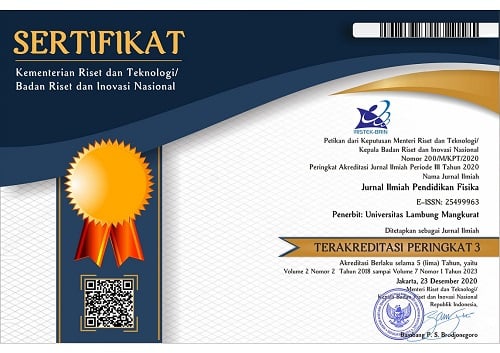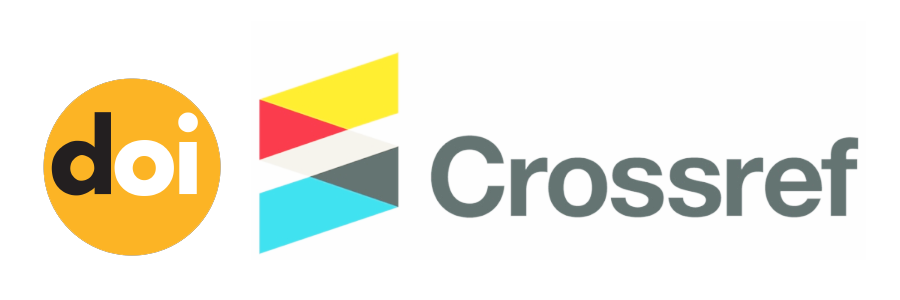Effectiveness of the CinQASE Web Integrated Learning Model to Train Higher Order Thinking Skills
Abstract
The lack of training in higher-order cognitive thinking skills in physics makes most students of class XI MIPA in a high school in Marabahan unable to solve problems that require the ability to analyze (C4) and evaluate (C5) well. This study was intended to describe the effectiveness of using the web-integrated CinQASE learning model to train higher-order thinking skills in the C4 and C5 domains. This study used the pre-experimental one-group pretest-posttest design. The efficacy of the web-integrated CinQASE learning model to train higher-order thinking skills is calculated with the eta-squared effect size for a paired sample t-test. In contrast, the description of students' achievement in higher-order thinking is viewed from the percentage of the average score of the student learning outcomes test on items that have C4 and C5 domains. The results showed that using the model had moderate effectiveness (η2 = 0.94) and helped train students’ ability to think at a higher level, as shown by an increase in students’ achievement in higher-level thinking in the good category. Thereby, the use of the web-integrated CinQASE learning model can supply considerable benefits in training students’ higher-order thinking skills. These results also write down a practical need for teachers and schools to implement learning approaches that use the potential of technology to enhance learners’ higher-order thinking skills in the 21st century.
Keywords
Full Text:
PDFReferences
Amto, A., Ertikanto, C., & Nyeneng, I. D. P. (2019). Pengaruh keterampilan berpikir kritis melalui pembelajaran berbasis aneka sumber belajar terhadap hasil belajar fisika siswa. Jurnal Pendidikan Fisika, 7(1), 28. doi: 10.24127/jpf.v7i1.1337
Ansari, B. I. & Taufiq. (2020). Pengembangan dan hambatan siswa dalam meningkatkan kemampuan berpikir tingkat tinggi matematika melalui metode improve. Numeracy, 7(2). doi: 10.46244/numeracy.v7i2.1190
Apino, E., & Retnawati, H. (2017). Developing instructional design to improve mathematical higher order thinking skills of students. Journal of Physics: Conference Series, 812, 012100. doi: 10.1088/1742-6596/812/1/012100
Arends, R. (2012). Learning to teach (9th ed). Dubuque, Iowa: McGraw-Hill.
Ariyana, Y., Pudjiastuti, A., Bestary, R., & Zamroni. (2019). Buku
Pegangan Pembelajaran Berorientasi pada Keterampilan Berpikir Tingkat Tinggi. Kementerian Pendidikan dan Kebudayaan.
Backfisch, I., Lachner, A., Hische, C., Loose, F., & Scheiter, K. (2020). Professional knowledge or motivation? Investigating the role of teachers’ expertise on the quality of technology-enhanced lesson plans. Learning and Instruction, 66, 101300. doi: 10.1016/j.learninstruc.2019.101300
Bakri, F., Vani, N. D., Permana, H., & Muliyati, D. (2021). Textbook with augmented reality technology: Improve critical thinking skill in elasticity concept. 030036. Jakarta, Indonesia. doi: 10.1063/5.0041679
Batlolona, J. R., Diantoro, M., & Latifah, E. (2019). Creative thinking skills students in physics on solid material elasticity. Journal of Turkish Science Education., 16(1), 48–61. doi: 10.12973/tused.10265a
Buckley, J., Archibald, T., Hargraves, M., & Trochim, W. M. (2015). Defining and teaching evaluative thinking: Insights from research on critical thinking. American Journal of Evaluation, 36(3), 375–388. doi: 10.1177/1098214015581706
Cohen, L., Manion, L., & Morrison, K. (2018). Research methods in education (Eighth edition). London ; New York: Routledge.
Dewi, M. R., Mudakir, I., & Murdiyah, S. (2016). Pengaruh model pembelajaran kolaboratif berbasis lesson study terhadap kemampuan berpikir kritis siswa. Jurnal Edukasi, 3(2), 29. doi: 10.19184/jukasi.v3i2.3526
Di, W., Danxia, X., & Chun, L. (2019). The effects of learner factors on higher-order thinking in the smart classroom environment. Journal of Computers in Education, 6(4), 483–498. doi: 10.1007/s40692-019-00146-4
Fikri, A. M. K., Sudarti, S., & Handayani, R. D. (2022). Analisis deskriptif kemampuan berpikir tingkat tinggi (HOTS) siswa ma unggulan nurul iman pokok bahasan suhu dan kalor dengan menggunakan taksonomi bloom. Jurnal Pendidikan MIPA, 12(2), 214–219. doi: 10.37630/jpm.v12i2.581
Ganapathy, M., Mehar Singh, M. K., Kaur, S., & Kit, L. W. (2017). Promoting higher order thinking skills via teaching practices. 3L The Southeast Asian Journal of English Language Studies, 23(1), 75–85. doi: 10.17576/3L-2017-2301-06
Gong, D., Yang, H. H., & Cai, J. (2020). Exploring the key influencing factors on college students’ computational thinking skills through flipped-classroom instruction. International Journal of Educational Technology in Higher Education, 17(1), 19. doi: 10.1186/s41239-020-00196-0
Gupta, T., & Mishra, L. (2021). Higher-order thinking skills in shaping the future of students. Psychology And Education, 58(2), 9305–9311.
Hafizah, S., Miriam, S., & Misbah, M. (2020). Meningkatkan keterampilan proses sains peserta didik pada materi elastisitas dan hukum hooke berorientasi learner autonomy. Jurnal Ilmiah Pendidikan Fisika, 4(2), 76. doi: 10.20527/jipf.v4i2.2060
Hariadi, B., Sunarto, M. J. D., Sagirani, T., Amelia, T., Lemantara, J., Prahani, B. K., & Jatmiko, B. (2021). Pengembangan model blended web mobile learning dengan aplikasi molearn untuk meningkatkan keterampilan berpikir tingkat tinggi siswa sma. Empiricism Journal, 2(2), 63–72. doi: 10.36312/ej.v2i2.560
Hartini, S., Liliasari, L., Sinaga, P., & Abdullah, A. G. (2022). Implementation of NPIVL to Improve Critical Thinking Skills of Pre-Service Physics Teacher. Berkala Ilmiah Pendidikan Fisika, 10(3), 362. doi: 10.20527/bipf.v10i3.15042
Hartini, S., Mariani, I., & Sulaeman, N. F. (2020). Developing of students worksheets through STEM approach to train critical thinking skills. Journal of Physics: Conference Series, 1567(4), 042029. IOP Publishing.
He, X., Singh, C. K. S., & Ebrahim, N. A. (2022). Quantitative and qualitative analysis of higher-order thinking skills in blended learning. Perspectives of Science and Education, 59(5), 397–314. doi: 10.32744/pse.2022.5.23
Huck, S. W. (2012). Reading statistics and research (6th ed). Boston: Pearson.
Hunaidah, H., Sahara, L., Husein, & Mongkito, V. H. R. M. (2022). Pengembangan e-modul model pembelajaran CinQASE berbasis flip pdf professional untuk meningkatkan hasil belajar fisika peserta didik. Jurnal Dedikasi Pendidikan, 6(1), 137–150.
Hunaidah, Susantini, E., Wasis, & Mahdiannur, M. A. (2022). Model Pembelajaran CinQASE (Collaborative in Questioning, Analyzing, Synthesizing, and Evaluating). Surabaya: Global Aksara Press.
Jailani, Sugiman, Retnawati, H., Bukhori, Apino, E., Djidu, H., & Arifin, Z. (2018). Desain pembelajaran matematika untuk melatihkan higher order thinking skill. Yogyakarta: UNY Press.
Kharida, L. A., Rusilowati, A., & Pratiknyo, K. (2009). Penerapan model pembelajaran berbasis masalah untuk peningkatan hasil belajar siswa pada pokok bahasan elastisitas bahan. Jurnal Pendidikan Fisika Indonesia, 5, 83–89.
Kolopita, C. P., Katili, M. R., & Thohir, R. M. (2022). Pengaruh media pembelajaran terhadap hasil belajar siswa pada mata pelajaran komputer dan jaringan dasar. Inverted: Journal of Information Technology Education, 2(1).
Lu, K., Yang, H. H., Shi, Y., & Wang, X. (2021). Examining the key influencing factors on college students’ higher-order thinking skills in the smart classroom environment. International Journal of Educational Technology in Higher Education, 18(1), 1. doi: 10.1186/s41239-020-00238-7
Mafudiansyah, M., Sari, S. S., & Arsyad, M. (2020). Analisis hasil belajar fisika di sma negeri 3 makassar. Jurnal Sains dan Pendidikan Fisika, 16(1), 8. doi: 10.35580/jspf.v16i1.15279
Maratin, H., & Shodikin, A. (2022). Development of single variable linear equation system question instruments based on higher order thinking skill (HOTS). Pedagogi: Jurnal Ilmu Pendidikan, 22(1), 34–38. doi: 10.24036/pedagogi.v22i1.1247
Milia, A. H., Trisna, S., & Yanti, I. R. (2022). Development of HOTS assessment instruments on static electricity materials for high school level. Berkala Ilmiah Pendidikan Fisika, 10(1), 73. doi: 10.20527/bipf.v10i1.11914
Miterianifa, M., Ashadi, A., Saputro, S., & Suciati, S. (2021). Higher order thinking skills in the 21st century: Critical thinking. Proceedings of the 1st International Conference on Social Science, Humanities, Education and Society Development, ICONS 2020, 30 November, Tegal, Indonesia. Dipresentasikan pada Proceedings of the 1st International Conference on Social Science, Humanities, Education and Society Development, ICONS 2020, 30 November, Tegal, Indonesia, Tegal, Indonesia. Tegal, Indonesia: EAI. doi: 10.4108/eai.30-11-2020.2303766
Muhsin, Razi, Z., & Nufus, H. (2022). Pembelajaran O2EMQ untuk meningkatkan kemampuan berpikir tingkat tinggi siswa. Amalgamasi: Journal of Mathematics and Applications, 1(1), 44–53. doi: 10.55098/amalgamasi.v1.i1.pp44-53
Ningrum, P. (2016). Meningkatkan keaktifan dan kemampuan berpikir kreatif melalui pembelajaran kolaboratif berbasis masalah materi kelarutan dan hasil kali kelarutan (ksp) siswa kelas xi sma negeri 10 semarang. Jurnal Pendidikan Sains, 04(1), 17–28.
Nurhayati, N., & Angraeni, L. (2017). Analisis Kemampuan Berpikir Tingkat Tinggi Mahasiswa (Higher Order Thinking) dalam Menyelesaikan Soal Konsep Optika melalui Model Problem Based Learning. Jurnal Penelitian & Pengembangan Pendidikan Fisika, 3(2), 119–126. doi: 10.21009/1.03201
Omar, M. S., & Awang, M. I. (2021). The Relationship Between Attitude And Higher Order Thinking Skills (Hots) Among Secondary School Students. Turkish Journal of Computer and Mathematics Education, 12(7), 82–90.
Ormrod, J. E., Anderman, E. M., & Anderman, L. H. (2019). Educational psychology: Developing learners (Tenth Edition). Hoboken, NJ: PEARSON.
Pradewi, G. I., & Wijayanti, W. (2019). The guiding of students based on higher order thinking skill at community-based alternative school. KnE Social Sciences. doi: 10.18502/kss.v3i17.4645
Rizki, S., Mastuang, M., & M, A. S. (2022). Pengembangan perangkat pembelajaran model direct instruction untuk melatihkan keterampilan proses sains siswa sma materi gerak melingkar. Jurnal Ilmiah Pendidikan Fisika, 6(1), 26. doi: 10.20527/jipf.v6i1.3295
Shabrina, A., & Diani, R. (2019). Pengembangan media pembelajaran fisika berbasis web enhanced course dengan model inkuiri terbimbing. Indonesian Journal of Science and Mathematics Education, 2(1), 9–26. doi: 10.24042/ijsme.v2i1.3922
Suarmawan, K. A., Made Ary Meitriana, & Iyus Akhmad Haris. (2019). Faktor-faktor eksternal yang mempengaruhi hasil belajar ilmu pengetahuan sosial siswa kelas viii di smp negeri 3 singaraja tahun ajaran 2018/2019. Jurnal Pendidikan Ekonomi, 11(2), 528–539. doi: 10.23887/jjpe.v11i2.21558
Sukma, A. K., & Kholiq, Abd. (2021). Pengembangan SI VINO (Physics Visual Novel) untuk melatihkan berpikir tingkat tinggi siswa sma. Jurnal Ilmiah Pendidikan Fisika, 5(2), 123. doi: 10.20527/jipf.v5i2.3313
Suyidno, S., Susilowati, E., Arifuddin, M., Misbah, M., Sunarti, T., & Dwikoranto, D. (2019). Increasing students responsibility and scientific creativity through creative responsibility based learning. Jurnal Penelitian Fisika Dan Aplikasinya (JPFA), 9(2), 178-188.
Syarifuddin, H., & Atweh, B. (2021). The use of activity, classroom discussion, and exercise (ACE) teaching cycle for improving students’ engagement in learning elementary linear algebra. European Journal of Science and Mathematics Education, 10(1), 104–138. doi: 10.30935/scimath/11405
Tang, N. (2017). Development of Analytical Thinking Skills Among Thai University Students.
Turidho, A., Oktalidiasari, D., & Saputri, N. W. (2019). Reading Assessment: Higher-Order Thinking Skills (Hots) through ICT. 20, 8.
Umam, K., & Azhar, E. (2021). Bagaimana bahan ajar berbasis website membantu meningkatkan kemampuan berpikir kritis matematis siswa? AKSIOMA: Jurnal Program Studi Pendidikan Matematika, 10(3), 1493. doi: 10.24127/ajpm.v10i3.3702
Utami, L. P. R. A., Suwastini, N. K. A., Dantes, G. R., Suprihatin, C. T., & Adnyani, K. E. K. (2021). Virtual reality for supporting authentic learning in 21st-century language classroom. Jurnal Pendidikan Teknologi dan Kejuruan, 18(1), 132–141.
DOI: https://doi.org/10.20527/jipf.v7i2.9191
Refbacks
- There are currently no refbacks.
Indexed by: Jurnal Ilmiah Pendidikan Fisika is licensed under a creative commons attribution-share alike 4.0 international license
Statistics Counter |

















